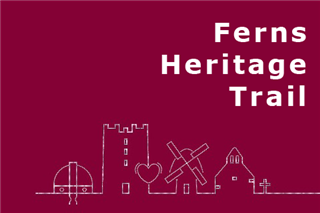
Explore the Rich Heritage of Ferns on Foot
St. Aidan founded a monastery in Ferns 1,400 years ago, which in time also became the royal seat and capital of the powerful kings of Leinster.
Our trail takes you through the heart of this historic village, where you will visit the remarkable medieval monastic remains at one end, and the imposing Norman Castle at the other.
If that isn’t enough, how about a miraculous well, the grave of a famous Irish King, and the tranquil beauty of a modern-day hermitage?
Ferns Village Heritage Trail

Grave of Rebel Commander Father John Murphy
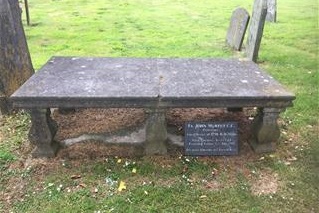
Fr John Murphy (1753-1798) was one of the main commanders of the 1798 Rebellion in Wexford. A gifted leader, he was eventually captured in Carlow by Crown forces, tortured and his body burned in a tar barrel. Some of his remains are laid here.
Grave of King Diarmait MacMurrough
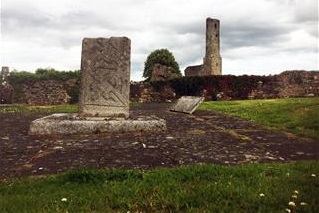
A brilliant and ruthless King,
Normal
0
false
false
false
EN-IE
X-NONE
X-NONE
/* Style Definitions */
table.MsoNormalTable
{mso-style-name:"Table Normal";
mso-tstyle-rowband-size:0;
mso-tstyle-colband-size:0;
mso-style-noshow:yes;
mso-style-priority:99;
mso-style-parent:"";
mso-padding-alt:0cm 5.4pt 0cm 5.4pt;
mso-para-margin-top:0cm;
mso-para-margin-right:0cm;
mso-para-margin-bottom:8.0pt;
mso-para-margin-left:0cm;
line-height:107%;
mso-pagination:widow-orphan;
font-size:11.0pt;
font-family:"Calibri",sans-serif;
mso-ascii-font-family:Calibri;
mso-ascii-theme-font:minor-latin;
mso-hansi-font-family:Calibri;
mso-hansi-theme-font:minor-latin;
mso-bidi-font-family:"Times New Roman";
mso-bidi-theme-font:minor-bidi;
mso-fareast-language:EN-US;}
Diarmait forged alliances overseas and recruited Norman mercenaries to help his campaigns in Ireland, ultimately precipitating a Norman invasion of his country. Dying in 1171, the broken shaft of a once enormous High Cross marks his resting-place.
Ruins of Medieval Cathedral
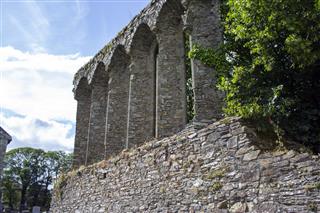
Thought to have been the ruins of the original medieval cathedral until recent years when investigations indicated that it is possibly a chapter house of the cathedral’s canons. Located to the east of the present Cathedral, the ruins consist of two side walls with beautiful closely set lancet windows,
St Mary's Abbey
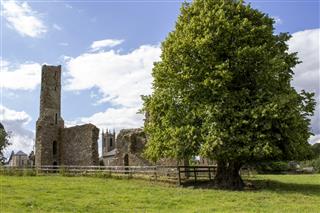
In c1160, King
Normal
0
false
false
false
EN-IE
X-NONE
X-NONE
/* Style Definitions */
table.MsoNormalTable
{mso-style-name:"Table Normal";
mso-tstyle-rowband-size:0;
mso-tstyle-colband-size:0;
mso-style-noshow:yes;
mso-style-priority:99;
mso-style-parent:"";
mso-padding-alt:0cm 5.4pt 0cm 5.4pt;
mso-para-margin-top:0cm;
mso-para-margin-right:0cm;
mso-para-margin-bottom:8.0pt;
mso-para-margin-left:0cm;
line-height:107%;
mso-pagination:widow-orphan;
font-size:11.0pt;
font-family:"Calibri",sans-serif;
mso-ascii-font-family:Calibri;
mso-ascii-theme-font:minor-latin;
mso-hansi-font-family:Calibri;
mso-hansi-theme-font:minor-latin;
mso-bidi-font-family:"Times New Roman";
mso-bidi-theme-font:minor-bidi;
mso-fareast-language:EN-US;}
Diarmait MacMurrough (see 2 above) founded a new Augustinian monastery here in Ferns. Easily recognisable with its ‘Round Tower’ type belfry, the Charter granted by Diarmuid promises the Abbey “a portion of all beer brewed in Ferns”.
St Edan's Cathedral

St Edan’s incorporates much of the earlier, much larger, medieval Cathedral (see 3 above), but without its transepts. Inside is the remarkable 800 year old effigy tomb of Bishop John St John (d.1243)
High Crosses
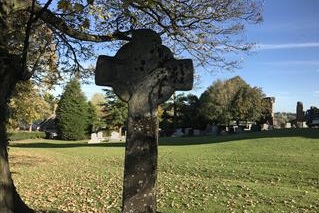
High Crosses are a unique feature of early Irish monasteries. In the grounds around the Cathedral are three plain granite crosses, a smaller stone cross and a cross slab.
St Mogue's Cottage

This picturesque 300 year old thatched cottage was probably the home of the Sexton or caretaker of the nearby St Edan’s Cathedral (see No. 5). It has been restored for community use.
St Peter's Church
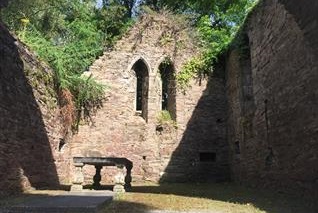
While this curious church was probably built some 400-500 years ago, it seems to have ‘recycled’ parts of much earlier buildings nearby. Two of the windows came from the ‘old’ Cathedral across the road (see 3 and 5 above)
St Mogue's Well

St Mogue, or St. Aidan (or Edan) as he is also known, is the patron saint of Ferns, founding a monastery here some 1,400 years ago. Ordering his followers to cut down a certain tree, a well of crystal water sprang up and has flowed here ever since.
St Aidan's Monastery
In 1990, on the site of the old Roman Catholic Church, the Sisters of Adoration built a convent, a church of perpetual adoration and individual stone hermitages, continuing a tradition of spiritual reflection extending back 1,400 years.
The Fr Murphy Monument
Taking the form of an ancient Irish High Cross, this monument carved in limestone on a granite plinth, commemorates Fr John Murphy (see 1 above), one of the most charismatic and beloved leaders of the 1798 Rebellion.
Visitor Centre and Ferns Tapestry
This is the Visitor Centre for Ferns Castle, and also houses the Ferns Tapestry, a community-led initiative showcasing the history of Ferns from the arrival of St. Aidan in 598AD to the coming of the Normans in 1169. The story is told over twenty-five panels, using the ancient art of crewel embroidery.
Ferns Castle
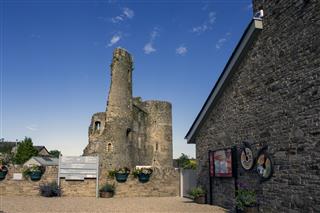
The first castle on this site was built nearly 900 years ago by King Diarmuid MacMurrough (see 2 above). A second castle was built here in the 1170s by the Normans, while the present castle – a Marshal castle – was completed in 1224.
Haughton's Plaque

Joseph Haughton was a Quaker who lived through the 1798 Rebellion and is remembered for his humanitarian efforts. An individual who tried in difficult circumstances, to keep the peace in Ferns in 1798 during the rebellion with the British, was Joseph Haughton. Find out more>>
St Aidan's Church
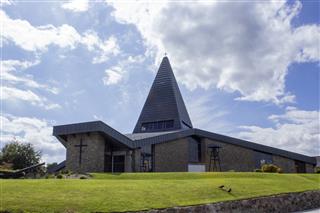
This is the new Church of St Aidan, begun in 1974. A plaque listing the names of all parish priests from 1644 is on the wall to the right of the altar.
1916 Commerorative Plaque
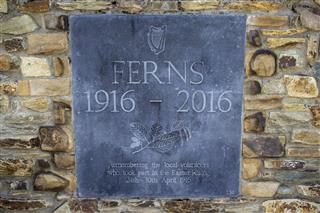
Outside of Dublin, the most extensive and effective campaign of the 1916 Rising was here in Wexford. The Ferns contingent was particularly active, sabotaging railway lines and taking the village itself on 28 April, 1916.
Click on a number on the map to reveal a brief description and image of the location.
As you walk along the trail…
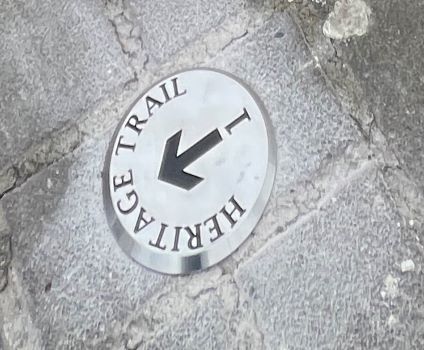
Watch for new Heritage Trail markers.
Because Ferns is an archaeologically sensitive site, we were advised to look for way markers in keeping with its historical significance and urban setting. As you walk the heritage trail, look out for these way marker studs which are minimally invasive and located on pavements throughout Upper and Lower Main St. – they number from 1 to 18. Two additional sites have been added since the map below was produced (the map will be updated in due course). The new additions are the Bee Skeps (now No 2) located in the old graveyard adjacent to St. Edan’s Cathedral and the Medieval Ferns Experience located on Upper Main St. (now No 11) The Ferns Heritage Trail was developed under Wexford Walking Trails – funding for the way marking studs was also sourced through Wexford Walking Trails. For a brief description of each site, go to ‘Points of Interest Along the Trail’ below.
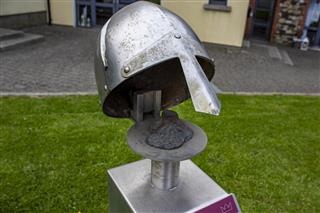
As you walk the trail through the village, keep an eye out for some Norman helmets along the way. Each installation includes some interesting information about the village’s past. There are also detailed descriptions on the heritage boards located at various points along the trail.
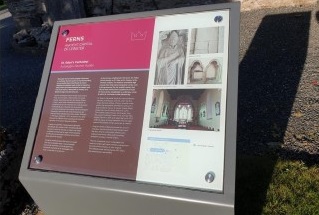

The addition of three large murals around the village depicting key characters in the Gaelic kingship/Norman story bring the rich medieval history of Ferns to life. Look carefully at each mural and you’ll notice symbols pointing to character traits and events linked to each character.
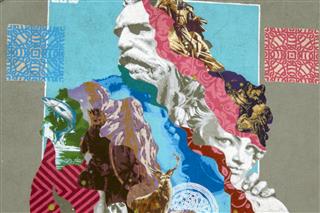
Points of Interest Along the Trail

1. Grave of Rebel Commander Father John Murphy
Fr John Murphy (1753-1798) was one of the main commanders of the 1798 Rebellion in Wexford. A gifted leader, he was eventually captured in Carlow by Crown forces, tortured and his body burned in a tar barrel. Some of his remains are laid here. Also, the remains of Fr Ned Redmond, who as a student in France saved the young Napoleon Bonaparte from drowning.

2. Bee Skeps
These giant skeps (traditional beekeeper’s hives) are public artworks designed for two locations Ferns, Wexford and St. David’s Cathedral, Pembrokeshire. They were commissioned by the Ancient Connections project, an EU funded cross border programme which connects the two communities through the practice of beekeeping, reflecting the medieval story of St. David and his friendship with St. Aidan who, legend has it, brought bees back to Ireland from Wales. The oversized skeps are made from Canadian red cedarwood and in Ferns, are home to a colony of our native Irish bee (apis meliferra meliferra), producing delicious Ferns honey. They are looked after by local beekeepers

3. Grave of King Diarmait MacMurrough
Local tradition says that a broken granite shaft of a High Cross with a distinctive fret pattern decoration marks the grave of Diarmait MacMurrough (d.1171), the deposed King of Leinster. Originally, a High Cross, the cross was destroyed (possibly during the Cromwellian invasion) and only the shaft remains. Diarmait MacMurrough is most famous for having invited the Normans to Ireland in 1169 A.D. A brilliant and ruthless King, Diarmait forged alliances overseas and recruited Norman mercenaries to help his campaigns in Ireland, ultimately precipitating a Norman invasion of his country. In more recent years, eminent archaeologists have suggested that it is more likely that the King of Leinster would have been buried in the sanctuary of the Abbey he built – just a stone’s throw from the broken shaft of a High Cross.

4. Ruins of a Chapter House
Thought to have been the ruins of the original medieval cathedral until recent years when investigations indicated that it is possibly a chapter house of the cathedral’s canons. Located to the east of the present Cathedral, the ruins consist of two side walls with beautiful closely set lancet windows, a feature of gothic architecture introduced by the Normans. Parts of two medieval high crosses lie within the bounds of the ruins and are fine examples of their type. Fragments of medieval cut stone also lie in this area.
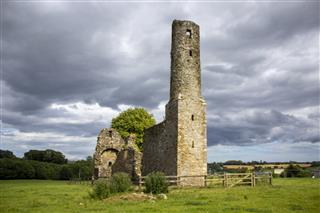
5. St Mary’s Abbey
In c1160, Diarmait MacMurrough founded an Augustinian Abbey in Ferns ‘for the health of my soul and my ancestors and successors’. Its foundation charter included an entitlement to a ‘portion of all beer brewed in Ferns’. Through the winter of 1167/8 MacMurrough took sanctuary in the Abbey whilst he awaited the arrival of his Anglo Norman allies. The Abbey was suppressed by Henry VIII of England in 1539 and the property and 630 acres of land reverted to the king. It is located within the original monastic enclosure of St. Aidan. Find out more>>

6. St Edan’s Cathedral
St Edan’s incorporates much of the earlier, much larger, medieval Cathedral (see 3 above), but without its transepts. Inside is the remarkable 800 year old effigy tomb of Bishop John St John (d.1243) showing him with his mitre and crozier, and with his feet resting upon a dog. Medieval features such as a double piscina (ritual stone basins for washing sacred vessels and celebrant’s hands) and columns with mason’s marks are still in evidence. Adjacent to the Cathedral, the old cemetery sits at the centre of the original monastic boundary established by St. Aidan in the 6th century.
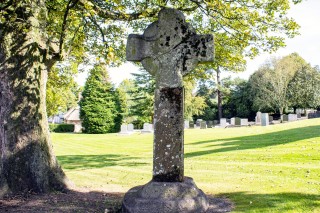
7. High Crosses
High Crosses are a unique feature of early Irish monasteries. In the grounds around the Cathedral are three plain granite crosses, a smaller stone cross and a cross slab. The heads of four High Crosses, dating to the 8th or 9th century, show the importance of Ferns as an early Christian monastic site, more than anywhere else in South Leinster. Find out more>>

8. St Mogue’s Cottage
This picturesque 300 year old thatched cottage in the Cathedral grounds is largely of 18th century origin with a 19th century addition. It was thatched until 1938 when the thatch was replaced by a tiled roof. Said to have been originally used as housing for clergy, it subsequently housed a sexton. It is now used for parish and community meetings and functions. It is also used by FÁS (the national training agency) as their headquarters in the community. After a major restoration project, including re-thatching, it was officially opened by President Mary McAleese in 2004.
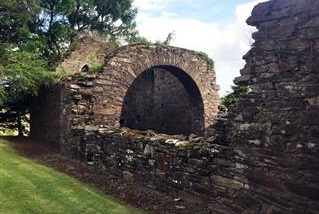
9. St Peter’s Church
Until recently this church was thought to have been built circa the 16th century. However, it is now thought to date from the time of Murchadh O’Lynum circa 1055. The remains of this church are located at the Northern entrance to Ferns, adjacent to St. Mogue’s Well. The Romanesque window in the south wall and the two Gothic lancets in the east wall indicate an earlier date but is now thought that these were “recycled”. It is believed they were taken from the medieval church at nearby Clone or St Mary’s Abbey.

10. St Mogue’s Well
St. Aidan, first Christian Bishop of the Diocese of Ferns, was born in Co. Cavan in the year 560 A.D. Mogue, still a popular name in the area, is a derivative of the old Irish name ‘Maogh-Óg’, meaning the young Aodh. In time this became Aodhaghan and later Aidan. On his return from Wales, having studied under St. David, he established his first monastic settlement on land granted to him by King Bran Dubh in Ferns. Find out more>>
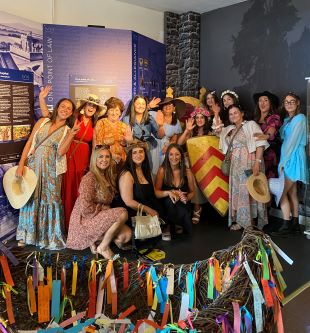
11. Medieval Ferns Experience
This is a visitor attraction where you can immerse yourself in fascinating tales of power and intrigue, of saints, Gaelic kings and Norman knight. Before the Normans arrived in Wexford, Gaelic kings were in power and the king of Leinster ruled from Ferns. The story is told through a range of media including audio visual, sensory and virtual reality. It takes an innovative and fun approach to telling our medieval story.
Open year round: Oct – May Wednesday – Saturday 11am – 5pm (last entry at 4pm) Jun – Sept Wednesday – Saturday: 11am – 4pm (last entry at 4pm)
Guided walking tours of key medieval sites – pre-booking required.
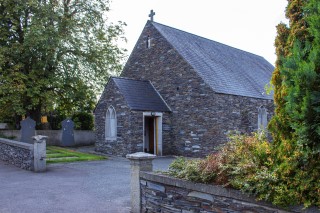
12. St Aidan’s Monastery
In 1990, on the site of the old Roman Catholic Church, the Sisters of Adoration built a convent, a church of perpetual adoration and individual stone hermitages, continuing a tradition of spiritual reflection extending back 1,400 years. With the exception of the altar, Tabernacle and Crosses, all the materials came from local sources. Here you can experience the solitude and the quietness of the 6th and 7th centuries with the comforts of modern living.
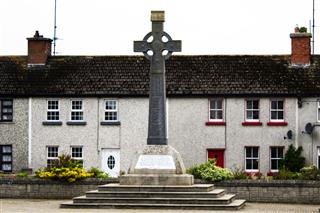
13. The Fr Murphy Monument
Taking the form of an ancient Irish High Cross, this monument carved in limestone on a granite plinth, commemorates Fr John Murphy (see 1 above), one of the most charismatic and beloved leaders of the 1798 Rebellion. Born in Tincurry, Ferns in 1753, Fr. Murphy was the primary leader of the Rebels in the 1798 insurrection against British rule. It was in Ferns and its hinterland that the spark that was to become the conflagration of 1798 was lit. Find out more>>
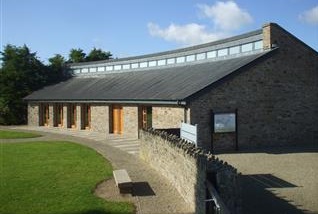
14. Visitor Centre and Ferns Tapestry
This is the Visitor Centre for Ferns Castle, and also houses the Ferns Tapestry, a community-led initiative showcasing the history of Ferns from the Iron Age to the coming of the Normans in 1169. The story is told over twenty-five panels, using the ancient art of crewel embroidery.

15. Ferns Castle
The original MacMurrough castle is no longer evident. The present Castle was built by the Marshal family in the 13th century. Originally the Castle had four towers however over its lifetime the castle was sacked and modified several times. The remaining south east tower features a beautiful chapel with a magnificent vaulted ceiling. Three windows light the interior of this architectural gem which is regarded as the finest of its kind in Ireland. If you climb to the top, panoramic views of the surrounding countryside indicate the strategic advantage the Castle had in terms of advance warning of attacks in the medieval period.

16. 1916 Commemorative Plaque
Outside of Dublin, the most extensive and effective campaign of the 1916 Rising was here in Wexford. The Ferns contingent was particularly active, sabotaging railway lines and taking the village itself on 28 April, 1916.
This plaque was put in place in 2016 to commemorate the role played by the people of Ferns in the 1916 Rising.

17. St Aidan’s Church
This is the new Church of St Aidan, begun in 1974. The foundation stone of this new Church of St. Aidan was laid on the Feast of St. Aidan, 31st January 1974. A plaque listing the names of of parish priests, from 1644, is on the wall to the right of the altar. Four parish priests named Doyle indicate the influence of the original Danish invaders on the population of Co. Wexford, while the presence of the Norman names such as Lambert and Rossiter also reflects that County Wexford was subject to a number of invasions.

18. Haughton’s Plaque
Joseph Haughton was a Quaker who lived through the 1798 Rebellion and is remembered for his humanitarian efforts. An individual who tried in difficult circumstances, to keep the peace in Ferns in 1798 during the rebellion with the British, was Joseph Haughton. Haughton was a Quaker who operated a merchant’s premises in the centre of the village. He famously refused to sell rope to a Yeoman, knowing that the rope was being purchased in order to hang rebels. Find out more>>
